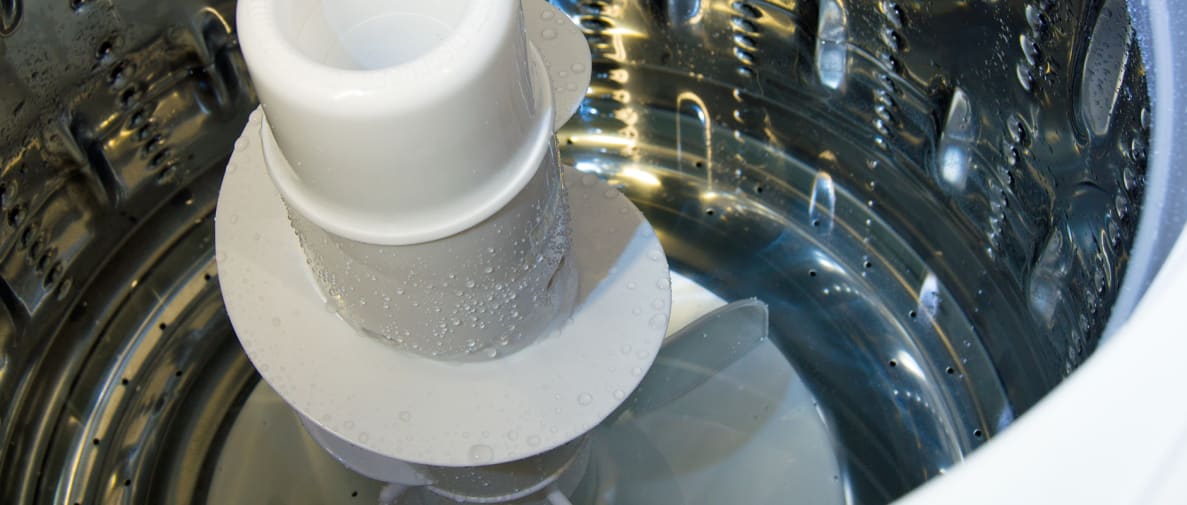That being said, the GHWN4250DWW has a sale price of just $550, which means it might work for a rental property or for someone who is waiting to trade up.
But if you're in the market for the GHWN4250DWW, we recommend you step up to another GE. The GTWN5550DWW is one of the best inexpensive top loaders we've tested, and our Best of Year winner for 2013. On sale, that machine can be found for only about $100 more than this one.
Design & Usability
Very Easy to Use
The GE GHWN4250DWW's controls are easy to read and feature large, bold print. On the cycle selector dial, all the options are clearly defined.
For example, the Colors cycle is divided into three sections depending on how dirty clothes are: heavy, regular, and light. Most machines at this price point have one knob for the cycle and a separate one for the soil level. Having them both on one knob helps you avoid mistakes and makes cycle selection easier.
{{ photo_gallery name="Design" }}
Otherwise, the machine had a few missteps. Most modern washers lock closed during a cycle, but this GE didn't. The drum will stop spinning if the lid is opened, but only after a few seconds of delay. Also, although GE advertises this machine as having a Quiet-By-Design feature, we heard plenty of evidence to the contrary. If you live on the same level as your washer, it's likely you'll hear it sloshing and whirring, especially during the spin cycle.
Performance & Features
Functional, but not fabulous
A washing machine should get your clothes clean. The GHWN4250DWW was outperformed by most other machines we've tested, and that's mostly because of design.
This washer has a pole agitator that's supposed to bash stains into submission. Compared to a front-loading washer that lets gravity do the agitation, or a top-loader with a gentler impeller or wash plate, this GE will do more damage to your clothes. That pole also takes up valuable space where clothes could be.
In a pole agitator washer, larger items are at risk of getting caught up and washed unevenly, which is one reason the GHWN4250DWW needed more water than average to get laundry moving around. Based on national averages, we calculate that the cost of running this GE to on the order of $77 a year—more than twice what the most efficient front-loaders we've tested cost to run. That means this machine could cost you an extra $150 over five years in cost of ownership compared to a more efficient washer.
For in-depth performance information, please visit the Science Page.
Conclusion
Step up for a better wash
The GE GHWN4250DWW might seem like a good deal, until you look at its below-average performance and above-average water consumption. We suggest you wait for a sale on the GE GTWN5550DWW.
That machine is also a top-loader, but it features a water-saving, space-maximizing drum design. On sale, the two machines are extremely similar in price, but the 5550 offers a clear performance improvement. In fact, the GTWN5550DWW was our choice for Best Of Year for an affordable top loader in 2013.
By the Numbers
In order to arrive at a solid conclusion, we rely on objective data. With washers, it's all about cleaning performance and efficiency.
Cleaning Performance
Our cleaning performance testing relies on standardized strips of stained cloth, mechanically coated in household substances like cocoa and red wine. To test the GHWN4250DWW, we washed these strips in standard laundry loads on the Regular Colors, Speeds Wash, Delicates, Regular Whites, and Heavy Colors cycles, which were chosen based on the owner's manual's instructions. After washing, we scanned the strips with a photospectrometer in order to determine how much of the stain was lifted.
Overall, this washer exhibited below average stain removal. It did the best with cocoa and red wine stains, and struggled with sebum (sweat) and carbon (dirt). We see this trend a lot amongst washing machines, but it was more pronounced with this GE.
Efficiency
Efficiency is two-pronged in our testing labs. It's a measure of what goes in and what comes out. Water and electricity are what goes in. To measure that, we hooked watt and water meters up to the GE GHWN4250DWW. We calculate, based on national averages, that this washer will cost you $77.78 a year to run. That's on par with cheaper top-loaders and roughly double what the average front-loader costs.
The second half of our efficiency equation is water retention. That's the amount of water laundry retains at the end of the cycle. The more water that is retained, the more time and energy your dryer will have to expend. In this regard, the GHWN4250DWW fell flat on its face. Test laundry came out soaking wet, so our dryers had to spend more time to get them dry.
Meet the tester
Jonathan Chan currently serves as the Lab Manager at Reviewed. If you clean with it, it's likely that Jon oversees its testing. Since joining the Reviewed in 2012, Jon has helped launch the company's efforts in reviewing laptops, vacuums, and outdoor gear. He thinks he's a pretty big deal. In the pursuit of data, he's plunged his hands into freezing cold water, consented to be literally dragged through the mud, and watched paint dry. Jon demands you have a nice day.
Checking our work.
Our team is here for one purpose: to help you buy the best stuff and love what you own. Our writers, editors, and lab technicians obsess over the products we cover to make sure you're confident and satisfied. Have a different opinion about something we recommend? Email us and we'll compare notes.
Shoot us an email


